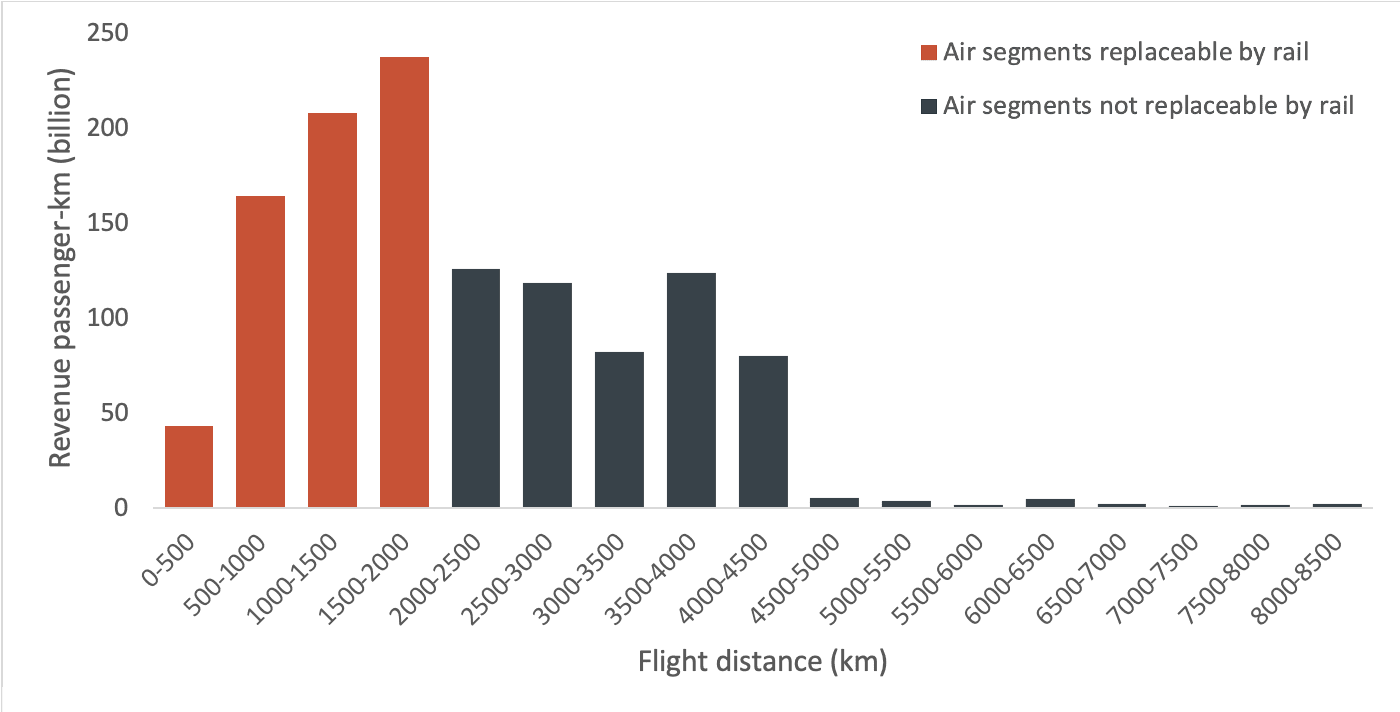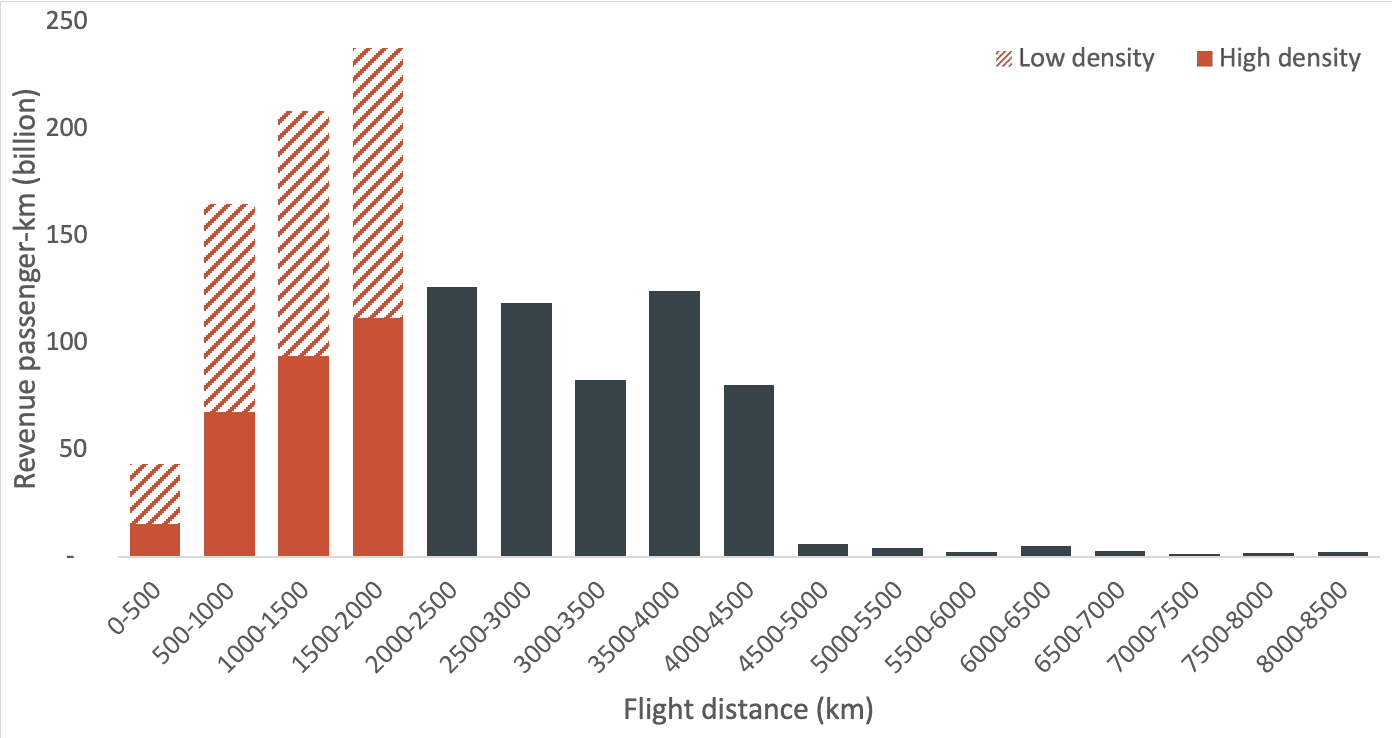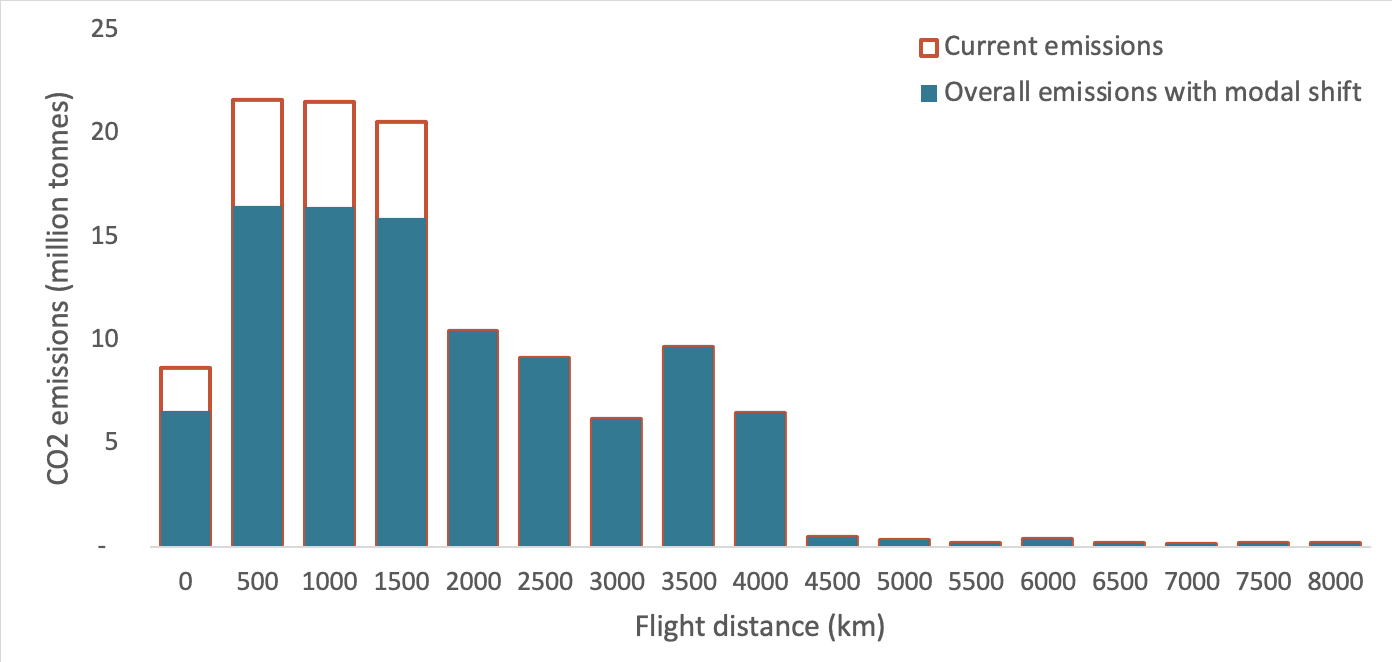Low-cost carriers and U.S. aviation emissions growth, 2005 to 2019
Blog
The bullet train to lower-carbon travel
Amid all the talk about reducing aviation emissions, modal shift does not get a lot of air time. However, the spread of high-speed rail (HSR) over the past decade has made trains a competitive, low-carbon alternative to short-haul flights. I can testify to this personally: since the launch of the Beijing-Shanghai HSR in 2011, my travel between the two cities has been entirely on trains rather than flights. More broadly, aviation decarbonization roadmaps have also started including modal shift as an important lever for reducing the carbon footprint of travel.
Proximity to city centers and simpler security checks give HSR advantages in terms of travel time. Travelers taking a train from Madrid to Barcelona (~500 km) arrive in under three hours; a train from Beijing to Shanghai (~1300 km) takes less than five hours. Because train travel over these distances is competitive with flying, it is likely that an extensive HSR network could have a material impact on air traffic. Transport and Environment estimates that intra-EU air traffic could be cut by 25% if high-speed rail service were available between all major cities in the region.
In the U.S., meanwhile, the fastest train (Amtrak’s Acela Express) runs at half the speed of its foreign counterparts and requires seven hours to travel between Boston and Washington D.C. (~700 km). HSR development in the U.S. has its champions, but the political challenges it faces appear to be great. Whether Joe Biden’s one trillion dollar infrastructure bill and his declaration of an “infrastructure decade” will help change the course remains uncertain.
This article investigates the potential of an air-to-rail modal shift in the US, and its climate implications. To identify routes on which a modal shift may occur, we consider two factors: travel distance and population density. Then we calculate the carbon emissions implications of such a shift.
Past research shows that HSR can typically substitute for flights up to 1000 km in distance, and they are most competitive for trips under 700 or 800 km. However, to estimate the maximum potential, we should consider the edge case: some HSR routes in China have been competing with flights over 1000 km, with the longest route reaching almost 2300 km. Using flights under 2000 km as a threshold, Figure 1 illustrates the distance segments replaceable by high-speed rail in the US (whether or not the rail infrastructure exists yet), which accounted for 54% of domestic traffic and 62% of CO2 emissions in 2019. The replaceable segments in the figure represent the contribution that HSR could make as a low-carbon alternative to air travel.

Figure 1. Modal shift potential based on flight distance
The figure reveals that short-haul flights make up half of the U.S. domestic market and are responsible for 62% of the emissions in 2019. The emissions share is greater than the traffic share because short-haul flights on average are significantly more carbon-intensive than longer flights, shown by previous ICCT analysis. Flights under 500 km, in particular, can emit three times as much CO2 as a train ride covering the same distance (Table 1). But short train routes are relatively rare because they are uncompetitive with cars.
Table 1. Average carbon intensity of 2019 US domestic flights by distance versus passenger rail
| Distance | Carbon Intensity (gCO2/passenger-km) | |
| Plane | Train* | |
| <500 km | 199 | 64 |
| 500–1000 km | 131 | |
| 1000–1500 km | 103 | |
| 1500–2000km | 86 | |
| >2000 km | 79 | |
*The average of diesel and electric trains, based on the current route mix, with a carbon intensity of 79 g CO2/passenger-km for diesel and 38 g CO2/passenger-km for electric (source: Miller, 2020)
We also assume that HSR would be built only between relatively dense urban areas, considering its high construction cost. We use a route’s annual passenger load as a proxy for population density. We estimate that U.S. domestic routes with 300,000 passengers per year or more (solid orange bars in Figure 2) are links between dense urban areas. A little less than half of the short-haul flights (under 2000km in this case) meet this criterion, and the short-haul, high-density segment as a whole represents almost a quarter (24%) of overall U.S. domestic traffic in 2019.

Figure 2. Modal shift potential based on distance and population density
Combining the route screening results and carbon intensity of both modes, we can estimate the maximum emissions reduction from a modal shift to rail. CO2 emissions in 2019 would have been 15% lower if travelers had replaced flights with electric-powered train travel. For short haul segments (< 2000km), emissions would have fallen by 23%. Smaller emission reductions—of 8% and 13%, respectively—would have resulted if the trains had operated with today’s diesel and electricity mix.

Figure 3. CO2 emissions by flight distance with modal shift to rail (assuming electric trains, and a carbon intensity of 38 g CO2/RPK)
Even if high-speed rail infrastructure were available, not all travelers on the identified routes would switch. Research has shown that competing HSR service can reduce air traffic by 7-28%. For instance, a study estimates that about 7% of intra-European short/medium haul traffic can be substituted by rail with no increase in travel time; the ratio increases to 17% if travel time is allowed to increase by 20%. In China, the introduction of HSR led to a 27-28% reduction in demand on competitive flight routes in the early years (2010-2013), and a 10% decrease in monthly departures in the longer term (2011-2016), according to two studies.
These studies estimate only voluntary shifts from air to rail, but there are many ways to promote additional modal shift. On one hand, lower ticket fares and better service can incentivize travelers to choose trains over planes. Increasing the connectivity between train stations and local transport also helps. On the other hand, government policies can directly bring about modal shifts. For example, France passed a law banning direct flights where a train trip of under 2.5 hours is available. Many European airlines established partnership with local railways to replace some of their short-haul flights; these include collaborations between KLM and NS, Lufthansa and Deutsche Bahn, and Austrian Airlines and ÖOB. These partnerships demonstrate that the relationship between aviation and rail can be synergistic rather than purely competitive. Also, particularly under 500 km, most of the environmental benefits of HSR could come from getting the many people who drive out of their cars, rather than the relatively few who fly out of planes.
While aircraft and fuel technology will continue to be key to decarbonizing aviation, modal shifts can make unique contributions. Specifically, they reduce pressure on the airline industry to achieve deep decarbonization amid rapid growth, while not jeopardizing demand for flights on more lucrative long-haul operations. Be on the lookout for a major ICCT report that shows how HSR fits into the deep decarbonization of global aviation.
Will the U.S. build high-speed rail? We don’t know. But given the clear benefits of modal shifting, the rationale for building a robust rail system is stronger than ever.
